#babyrousa celebensis
Text

North Sulawesi babirusa Babyrousa celebensis
Observed by bertharris, CC BY-NC
41 notes
·
View notes
Text



North Sulawesi Babirusa (Babyrousa celebensis), male, family Suidae, found on Sulawesi and nearby islands in Indonesia
photographs: Oregon Zoo, Masteraah, HarshLight
366 notes
·
View notes
Text

The North Sulawesi babirusa (Babyrousa celebensis) is a pig-like animal native to Sulawesi and some nearby islands (Lembeh, Buton and Muna) in Indonesia. It has two pairs of large tusks composed of enlarged canine teeth. The upper canines penetrate the top of the snout, curving back toward the forehead. The North Sulawesi babirusa is threatened from hunting and deforestation. -Wikipedia
78 notes
·
View notes
Text
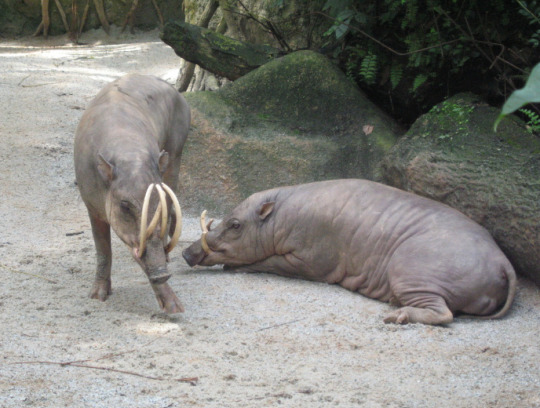
Sulawesi Babirusa (Babyrousa celebensis)
Family: Pig Family (Suidae)
IUCN Conservation Status: Vulnerable
Native to the islands of Sulawesi, Pulau Muna, Butung and Lembeh in Indonesia, the Sulawesi Babirusa is a small, slender, almost entirely hairless species of wild pig best known for the four enormous curled tusks seen in adult males (which are derived from highly elongated canine teeth,) although adult females also possess a single pair of smaller, less elaborate tusks protruding from their lower jaws. The tusks of a male babirusa are used to intimidate rival males and impress potential mates (with females generally preferring males with larger, curlier tusks,) although despite their impressive appearance they are brittle and unsuited for fighting; males generally resolve conflicts through intimidation alone, but if a fight does occur they instead rear up onto their hind legs and strike at each other with their front hooves, similar to a clumsier version of the boxing behaviour of hares. Typically inhabiting dense forests or canebrakes (forest-like areas dominated by tall bamboo of the genus Arundinaria,) members of this species tend to remain near permanent bodies of water such as rivers and large ponds and feed mainly on fallen fruit, although like other pig species they are unspecialised omnivores and will also readily consume leaves, roots and small invertebrates. Female Sulawesi Babirusas live in groups of around 15 adults accompanied by their young, while males are generally solitary outside of the mating season (between January and August). Unlike most pigs females of this species produce only small litters of 1-2 piglets each year, with young being born tuskless and covered in a coat of short, reddish-brown hair.
--------------------------------------------------------------------------
Image Source: https://www.inaturalist.org/taxa/74099-Babyrousa-celebensis
#Sulawesi Babirusa#babirusa#pig#pigs#suidae#zoology#biology#mammalogy#animal#animals#wildlife#Asian wildlife#Indonesian wildlife#ungulates#ungulate#even-toed ungulate#even-toed ungulates#artiodactyla#artiodactyls#wild pig#wild pigs#mammal#mammals
32 notes
·
View notes
Text
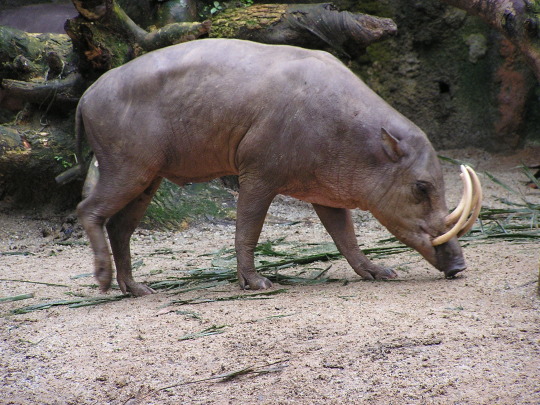
North Sulawesi babirusa (Babyrousa celebensis)
This species is found only on and around the Indonesian island of Sulawesi. They live in tropical forests and swamps, and like other pigs are omnivores which will eat roots, tubers, leaves, fruits, and small animals. Male babirusas are infamous for their tusks, which can grow back so far that they pierce and grow into the animal’s forehead!
#markhors-menagerie#animal facts#animals#biology#fun facts#ungulates#even toed ungulates#pigs hippos & kin#babirusa#North Sulawesi babirusa
4 notes
·
View notes
Text
Sulawesi Babirusa Babyrousa celebensis – Palm Oil Detectives
Source: Sulawesi Babirusa Babyrousa celebensis – Palm Oil Detectives

View On WordPress
0 notes
Photo

North Sulawesi babirusa (Babyrousa celebensis) at Gorontalo in Sulawesi, Indonesia
Chien C. Lee
76 notes
·
View notes
Photo

Sulawesi babirusa (Babyrousa celebensis)
Photo by Chien Lee
#sulawesi babirusa#babirusa#babyrousa celebensis#babyrousa#suini#suidae#suina#artiofabula#artiodactyla#euungulata#scrotifera#laurasiatheria#boreoeutheria#eutheria#mammalia#tetrapoda#vertebrata#chordata
40 notes
·
View notes
Photo

1 note
·
View note
Photo
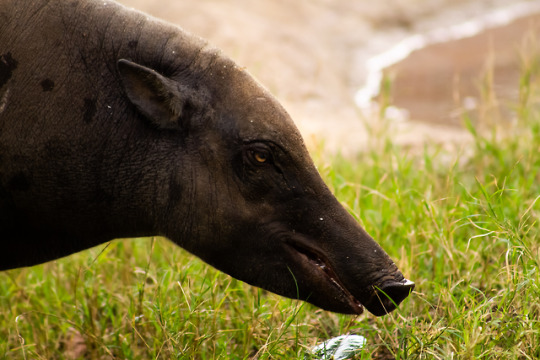
Babirusa (Babyrousa babyrussa celebensis)
taken at the LA zoo in Los Angeles, California
status: vulnerable
I have a really hard time getting a decent photo of these guys, glad to have gotten one of a female this time. Maybe the male next time!
#Babirusa#Babyrousa babyrussa celebensis#swine#animal#wildlife#photo#photography#la zoo#los angeles zoo#canon rebel t3#lightroom#adobe lightroom
1K notes
·
View notes
Text

North Sulawesi babirusa Babyrousa celebensis
Observed by birdexplorers, CC BY-NC
18 notes
·
View notes
Photo
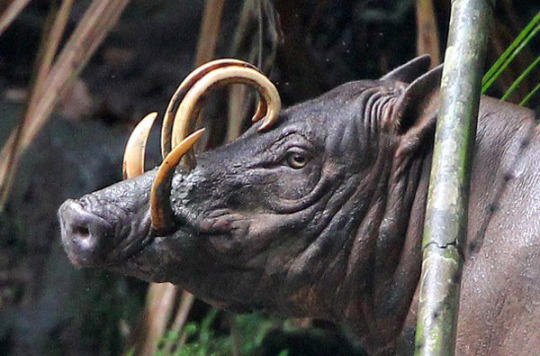



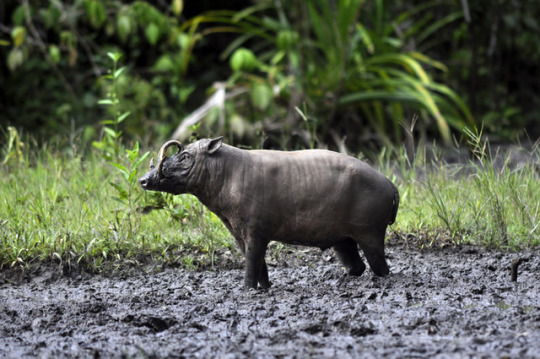
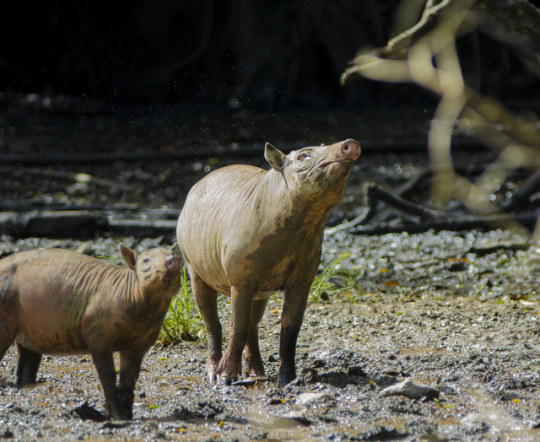


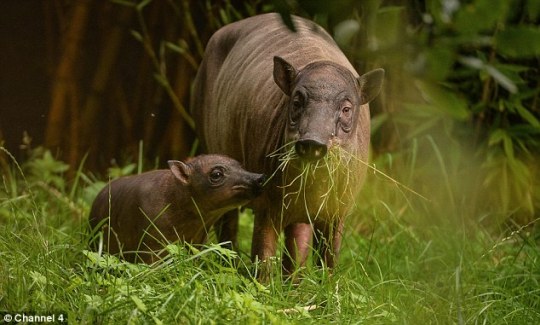
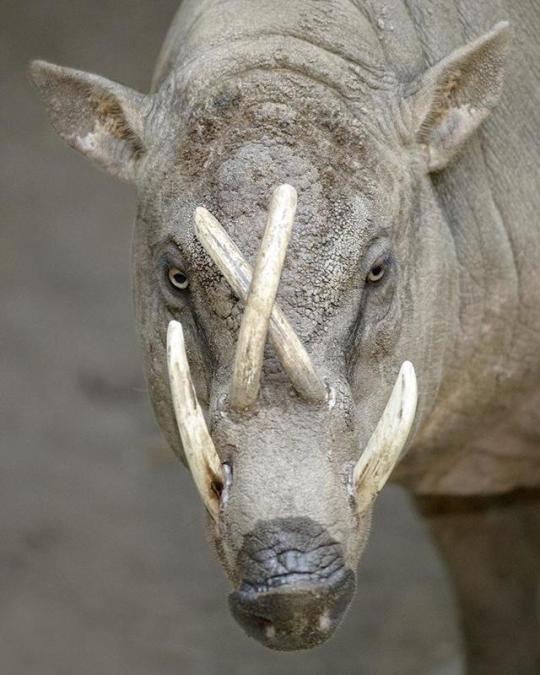

[x]
The babirusas, also called deer-pigs are a genus, Babyrousa, in the swine family found in the Indonesian islands of Sulawesi, Togian, Sula and Buru. All members of this genus were considered part of a single species until 2002, the babirusa, B. babyrussa, but following the split into several species, this scientific name is restricted to the Buru babirusa from Buru and Sula, whereas the best-known species, the north Sulawesi babirusa, is named B. celebensis. The remarkable "prehistoric" appearance of these mammals is largely due to the prominent upwards incurving canine tusks of the males, which actually pierce the flesh in the snout.
All members of the genus were considered part of a single species until recently. The split, which uses the phylogenetic species concept, is based on differences in size, amount of hair on body and tail-tuft, and measurements of the skull and teeth.
Babirusa are notable for the long upper canines in the males. The upper canines of male babirusa emerge vertically from the alveolar process, penetrating through the skin and curving backward over the front of the face and towards the forehead.The lower canines also grow upwards. The canines of the female are either reduced or absent. The structure of the male's canines vary by species. In the golden babirusa, the upper canines are short and slender with the alveolar rotated forward to allow the lower canines to cross the lateral view. The Togian babirusa also has the same characteristics and the upper canines always converge. The North Sulawesi babirusa has long and thick upper canines with a vertically implanted alveolar. This caused the upper canines to emerge vertically and not cross with the lower canines. Babirusa also vary by species in other characteristics. The golden babirusa has a long, thick pelage that is white, creamy gold, black or gold overall and black at the rump. The pelage of the Togian babirusa is also long but not as that of the golden babirusa. The Togian babirusa has a tawny, brown or black pelage that is darker on the upper parts than in the lower parts. The North Sulawesi babirusa has very short hair and appears bald. The female babirusa has only one pair of teats. The litter size for a babirusa is usually one or two piglets.
Babirusa are native to Sulawesi, some of the Togian Islands, the Sula Islands and Buru. In Sulawesi, they range from the northern peninsula to the south and south east provinces. Although babirusas are present on both Sulawesi and Sula, they are not found on the large islands between the two, the Banggai Archipelago. It has been hypothesized that the unusual distribution is due to their being transported by humans as gifts bestowed by native royalty. The preferred habitat of babirusa are tropical rainforests along river banks.
Like all pig species, babirusa have an omnivorous diet with an intestinal tract similar to that of the domestic pig. Because it does not have a rostral bone in the nose, a babirusa does not dig with its snout like other pigs do except in mud and swampy grounds. The diet of the babirusa includes leaves, roots, fruits and animal material. Apparently, the strong jaws of a babirusa are capable of easily cracking hard nuts.
Male babirusa tend to live solitarily while adult females can be found in groups with young. Groups of female and young babirusa may number up to 84 individuals, most of which contain no adult males. Males rarely travel in pairs or trios. The tusks of the adult males are used in intraspecific fighting. The upper tusks are for defense while the lower tusks are offensive weapons. If a babirusa does not grind its tusks (achievable through regular activity), they can eventually keep growing so as to penetrate the animal's own skull.
Babirusas are protected in Indonesia and killing them is illegal in most cases. However, poaching remains a significant threat to the babirusa. Additionally, commercial logging operations threaten the babirusa by habitat loss, and also reduce cover, making the babirusa more exposed to poachers. All extant species of babirusa are listed as vulnerable or endangered by the IUCN.
326 notes
·
View notes
Photo
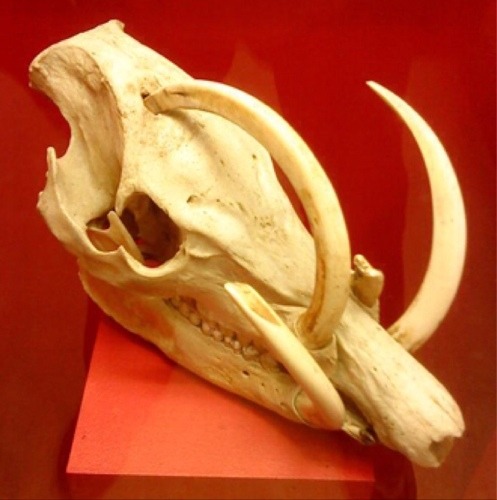
What Hath Evolution Wrought?
A babirusa is a kind of pig (known formerly as Babyrousa babyrussa celebensis). A rather strange looking pig that lives in the Indonesian islands, the babirusa has anatomical features more reminiscent of sheep (two-chambered stomachs) which suggests to biologists that the babirusa diverged early in its genetic history from the mainline of pig evolution. Another amazing feature of the babirusa is the rather strange and amazing tusks of the males. There are two lower tusks used in combat (perhaps against other pigs or to aid in plowing up dirt while looking for goodies to eat), and two further back that apparently protect their foreheads from the fighting and plowing… or possibly to merely look good for the pig-ladies.
Perhaps, these pigs took an evolutionary road going in the wrong direction. The rear tusks never stop growing, and as they lengthen they curve into the most marvelous shapes, until… yes, until they actually curve into and begin to impale their own skulls. Ouch!
Annie R
Photo supplied to TetZoo by Henrik Petersson. Read the TetZoo blog at: http://scienceblogs.com/tetrapodzoology/2010/03/08/babirusa-impales-own-head/ Other fun sources: http://www.lazoo.org/animals/mammals/babirusa/ http://www.wired.com/2014/05/the-creature-feature-10-fun-facts-about-the-babirusa/
184 notes
·
View notes
Photo
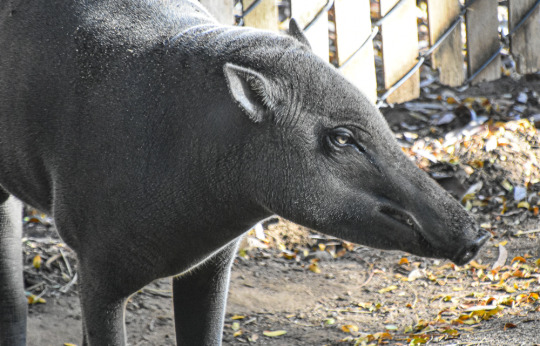
BABIRUSA
Babyrousa babyrussa celebensis
Los Angeles Zoo and Botanical Gardens
Los Angeles, California
©Laura Quick
Babirusa is a wild pig native to the Indonesian archipelago. This is a female - the male babirusa are known for their bizarre tusks (see them here and a video here), which, if they’re not worn down or broken in combat, will eventually grow long enough to pierce the animal’s skull. Prehistoric paintings of babirusa found in caves on the island of Sulawesi in Indonesia have been dated back at least 35,400 years (to the ice age Pleistocene epoch).
Other posts you might like:
South American Tapir (baby)
Mangalitza - Curly Coated Pig
Malayan Tapir with Black Swan
#babirusa#babyrousababyrussacelebensis#indonesia#southeast asia#pig deer#wild pig#los angeles zoo#los angeles zoo and botanical garden#©laura quick#docent class#pretty eyes#mammalia#sparse hair#weird bristly skin#omnivore
4 notes
·
View notes
Text

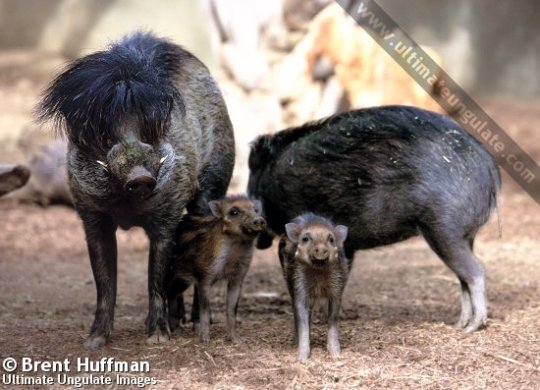
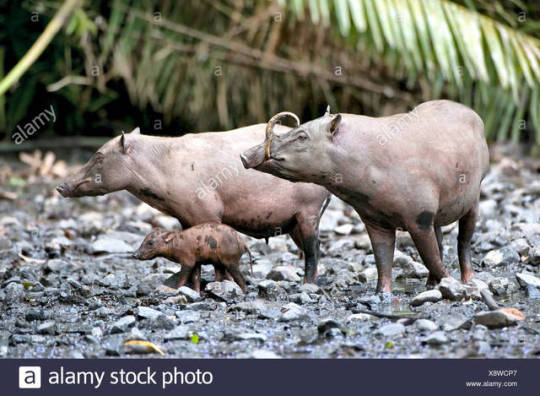
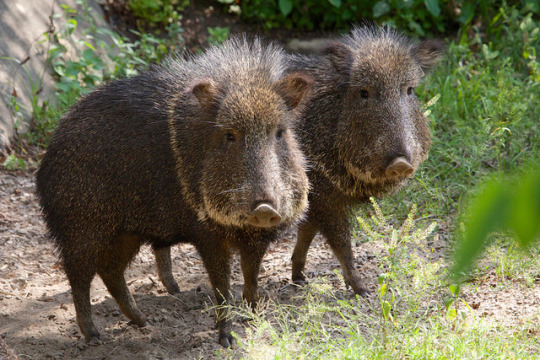
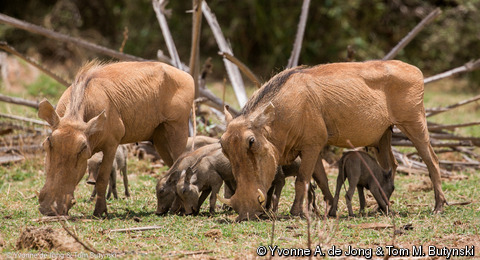
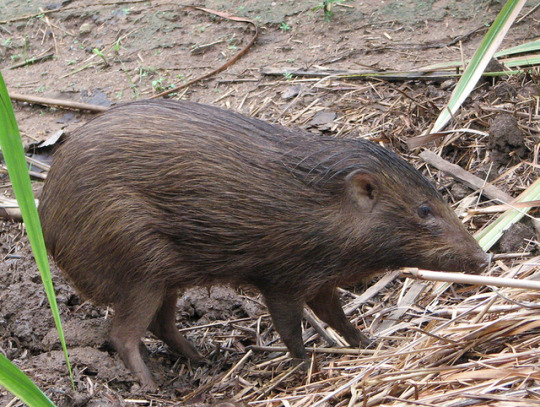

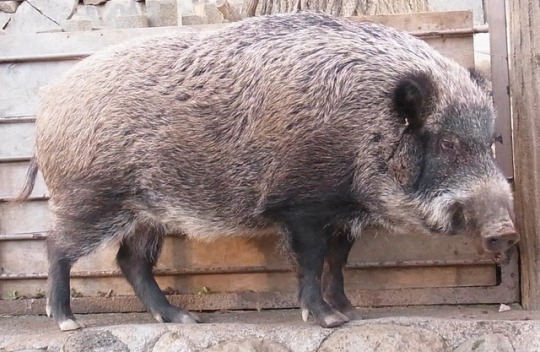

Happy Lunar New Year
Have some wild swine
Javan Warty Pig/Sus verrucosus
IUCN Status Endangered
Visayan Warty Pig/Sus cebifrons
IUCN Status Critically Endangered
Sulawesi Babirusa/ Babyrousa celebensis
IUCN Status Vulnerable
Chacoan Peccary/Catagonus wagneri
IUCN Status Endangered
Desert Warthog/Phacochoerus aethiopicus
IUCN Status: Least Concern
Pygmy Hog/Porcula salvania
IUCN Status: Critically Endangered
Red River Hog/Potamochoerus porcus
IUCN Status: Least Concern
Population decreasing
Japanese Wild Boar/Sus scrofa leucomystax
IUCN Status: nominate species least concern
Subspecies unevaluated
Bush Pig/Potamochoerus larvatus
IUCN Status Least Concern
#lunar new year#chinese new year#year of the pig#year of the boar#pigs#hogs#boars#wild boars#sows#critically endangered#endangered#endangered species#Warty Pig#bush pig#Pygmy Hog#Red River Hog#warthog#peccary
151 notes
·
View notes
Photo

BABIRUSA Babyrousa babyrussa celebensis Los Angeles Zoo and Botanical Gardens Babirusa is a wild pig native to the Indonesian archipelago. This is a female - the male babirusa are known for their bizarre tusks, which, if they're not worn down or broken in combat, will eventually grow long enough to pierce the animal's skull. Prehistoric paintings of babirusa found in caves on the island of Sulawesi in Indonesia have been dated back at least 35,400 years (to the ice age Pleistocene epoch). #babirusa #omnivore #babyrousababyrussacelebensis #pigdeer #wildpig #losangeleszooandbotanicalgardens #losangeleszoo #lazoo #lauraquick #mammalia #prettyeyes #weirdbristlyskin #sparsehair https://www.instagram.com/p/B4I54cIHjoC/?igshid=1286e98dbbimc
#babirusa#omnivore#babyrousababyrussacelebensis#pigdeer#wildpig#losangeleszooandbotanicalgardens#losangeleszoo#lazoo#lauraquick#mammalia#prettyeyes#weirdbristlyskin#sparsehair
3 notes
·
View notes